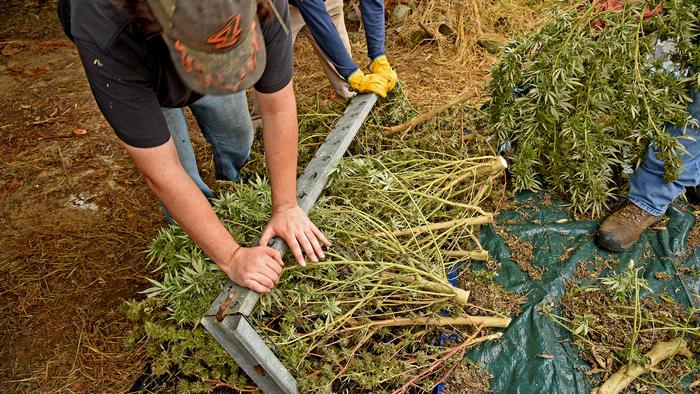A new North Carolina State University study examining the availability and content of commercial stock farmworker photos – images often used in health- and safety-education materials for farmworkers – shows a dearth of useful depictions of the people who work on farms and the tasks they perform. The study’s recommendations could lead to more relevant education materials that gain more attention and engagement from farmworkers

Credit: NC State University
A new North Carolina State University study examining the availability and content of commercial stock farmworker photos – images often used in health- and safety-education materials for farmworkers – shows a dearth of useful depictions of the people who work on farms and the tasks they perform. The study’s recommendations could lead to more relevant education materials that gain more attention and engagement from farmworkers
“I was really interested in how farmworkers were represented in stock-photo libraries,” said Catherine LePrevost, agromedicine extension specialist and associate extension professor in NC State’s Department of Applied Ecology. “A lot of my work is with farmworkers and creating interventions, including health-education interventions. Right now, we’re doing a lot of work with digital inclusion with farmworkers.
“My suspicion was that we would find a lot of stock photos that didn’t represent the people who are actually working in agriculture.”
The study confirmed that suspicion.
The researchers – including a team from East Carolina University – scoured commercial stock-image libraries online to find photos of farmworkers. They found 127 photos of “farmworkers” or “women farmworkers”; two of the five photo libraries queried had no relevant images at the time of the search.
Only 66 of the 104 photos that included a person showed the person’s face; 23 photos did not include a person at all. Most of the people who were shown were young or middle-aged adults who tended to be light-skinned.
About three-quarters of the photos showed manual or hand labor rather than mechanized work.
“Not only is the work not mechanized, but it hardly represents the type of agriculture we have in North Carolina and across the country,” LePrevost said. “It’s challenging to think about how to develop educational materials for the future of agriculture in terms of technology and mechanization. Having stock photos that don’t align with that reality doesn’t help matters.”
Only 11 of 89 photos that showed farmworkers working also depicted some type of hazard. And only 16 of the 89 photos showed farmworkers wearing personal protection equipment – gloves and hats were the most likely items worn. One photo even showed a child performing agricultural work.
“As educators. we need diverse images of personal protective equipment so that we can create tailored safety messages depending on the conditions faced by farmworkers, whether that’s extreme heat, chemicals or other hazards,” LePrevost said.
The researchers say that resources appear to be an obstacle to the creation of useful materials.
“If people don’t have a lot of resources, if they haven’t budgeted to have different photos taken, then they may end up relying on conventional stock photos, even when those photos were originally taken for a much different purpose. That’s what ends up in our educational materials,” LePrevost said.
Overall, the researchers say that the lack of useful materials means there’s a missed opportunity to educate farmworkers.
“The danger here is that people don’t perceive materials as relevant, and without that relevance they are less likely to use protective behaviors that we’re trying to encourage through North Carolina Extension programs,” LePrevost said.
“I’m really interested now in thinking about how we can engage agricultural communities and then develop materials that are tailored and relevant to have a positive impact on safety behaviors.
“We know that this has been a problem, but hopefully documenting it can help people build resources into their budgets to develop more relevant images,” LePrevost added. “This study is a call to action for people in agricultural safety and health to think about how we can work together and support each other – especially farmworkers – to develop more relevant images.”
The study appears in the Journal of Agromedicine. The research was supported by the National Library of Medicine of the National Institutes of Health under award number G08LM013198. The content is solely the responsibility of the authors and does not necessarily represent the official views of the National Institutes of Health.
– kulikowski –
Note to editors: The abstract of the paper follows.
“Assessing Stock Photos for Farmworker Health and Safety Education Materials”
Authors: Catherine E. LePrevost, Emery L. Harwell and Michelle A. Jewell, North Carolina State University; Abdul G. Zahra, Jose A. Robles Arvizu and Joseph G. L. Lee, East Carolina University
Published: June 21, 2024 in Journal of Agromedicine
DOI: 10.1080/1059924X.2024.2368728
Abstract:
Objectives: The aim of this study was to analyze how farmworkers are represented in stock photos available in commercial libraries for use in agricultural health and safety education materials.
Methods: We searched for images in five commercial stock photo libraries using the terms “farmworkers” and “women farmworkers” in April 2022. We used quantitative content analysis. We coded each image for containing a visible face, age, gender, skin color, work activity, mechanization, presence of hazards, technology use, and protective equipment/clothing after establishing inter-coder reliability. We used descriptive statistics to characterize the available stock photos.
Results: We identified stock photos (n = 127) in three databases (Adobe Stock Images, Canva, and Getty Images). Two databases (Microsoft Office Image Library and Pixabay) had no relevant images at the time of the search. Only half of the photos analyzed contained a face. Light skin colors and young or middle-aged adults were more common. A majority of farming activities represented in photos were manual tasks (e.g. harvesting) with few depictions of equipment, hazards, and protective equipment/clothing.
Conclusions: Health and safety professionals tasked with developing materials for education in agricultural settings face a severe lack of imagery pertinent to the realistic conditions of farmworkers in the United States. In the databases we reviewed, photos displaying human faces, photos showing a range of skin colors and ages, and photos displaying an array of different farm hazards are likely not sufficient for material development. Health and safety professionals may benefit from sharing photos from their own work with other professionals and allocating resources for professional photo shoots in their material development projects.
Journal
Journal of Agromedicine
DOI
10.1080/1059924X.2024.2368728
Method of Research
Observational study
Subject of Research
Not applicable
Article Title
Assessing Stock Photos for Farmworker Health and Safety Education Materials
Article Publication Date
21-Jun-2024
COI Statement
No potential conflict of interest was reported by the author(s).




